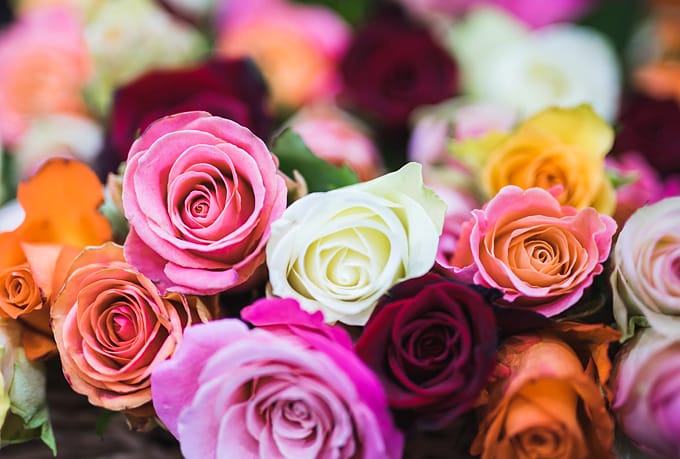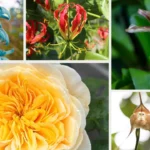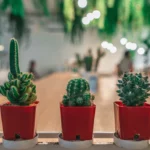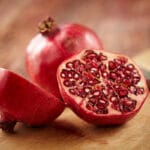Flowers! They’re nature’s confetti, adding splashes of color and beauty wherever they bloom. But did you know there’s a whole lot more to these delicate wonders than meets the eye? Get ready to have your mind blown with these ten fascinating facts about flowers, their significance in our world, and the intriguing mysteries they still hold.
10 Amazing Facts About Flowers
From their surprising history to their crucial role in the ecosystem, flowers never cease to amaze us. Let’s delve into ten captivating facts that showcase the wonder of these botanical marvels:
- Tulips Once Outpriced Gold! During the 17th century “Tulip Mania” in Holland, a single tulip bulb could cost more than a house! This speculative bubble eventually burst, highlighting the captivating allure these vibrant blooms held over people.
- An Underwater Bloom? You Bet! The lotus flower, a symbol of resilience, flourishes in muddy ponds, its stem stretching to the surface to unveil its stunning petals, proving that beauty can emerge from the most unexpected places.
- Sunflowers: Nature’s Timekeepers Sunflowers track the sun’s movement throughout the day, their large flower heads turning eastward in the morning and westward as the sun sets, acting like natural sundials.
- Daisies: A Symbol of Innocence These cheerful flowers, with their bright yellow centers and white petals, have symbolized purity, innocence, and childhood for centuries, inspiring countless works of art and literature.
- Narcissus: A Tale of Vanity Named after the Greek myth of Narcissus, who fell in love with his reflection, this delicate flower serves as a reminder that true beauty goes beyond outward appearances.
- Roses: A Timeless Classic These fragrant beauties have symbolized love, beauty, and passion for centuries, captivating hearts and inspiring art, literature, and perfumes, solidifying their place as a timeless treasure.
- Lilies: Elegance and Grace Lilies, with their elegant trumpet-shaped flowers, symbolize purity and grace in many cultures. The white lily, in particular, holds deep religious significance, often associated with the Virgin Mary.
- Flowers: More Than Just Pretty Faces Flowers like lavender and chamomile are known for their calming properties and are often used in aromatherapy. Others, like marigolds, act as natural pest repellents.
- Flowers: Essential for a Healthy Planet Flowers are crucial for maintaining a healthy ecosystem. They provide food and shelter for various insects, birds, and animals and are vital for pollination, essential for the production of many fruits and vegetables.
- Climate Change: A Threat to Blossoms Climate change poses a severe threat to flowers worldwide. Rising temperatures, shifting precipitation patterns, and extreme weather events can disrupt flowering times, pollination, and seed dispersal, impacting entire ecosystems and food production.
What is an Interesting Fact About Flowers?
Beyond their captivating beauty, flowers boast incredible diversity in size. The watermeal, the smallest flower, measures a minuscule 0.1mm in diameter, while the Rafflesia arnoldii, the largest flower globally, can grow to a whopping 3 feet across. This extraordinary size range highlights the incredible variation within the plant kingdom.
Flowers also hold deep cultural and historical significance. We use them to express love, offer condolences, and celebrate life’s milestones. Roses, for example, are a classic symbol of love and passion, while lilies are often associated with purity and innocence.
Beyond their beauty and symbolism, some flowers possess hidden talents, like healing properties. Lavender and chamomile are famous for their calming and therapeutic qualities. Interestingly, roses are related to apples and other fruits, showcasing the interconnectedness of the plant world.
Scientists are constantly uncovering fascinating facts about flowers. As our understanding of these botanical wonders continues to expand, who knows what other secrets we’ll unveil?
What are Some Facts About a Perfect Flower?
The idea of a “perfect flower” is a bit of a myth. While there’s no single blueprint for floral perfection, scientists sometimes use the term to describe flowers containing both male and female parts, allowing them to self-pollinate.
However, even these “perfect” flowers might still benefit from cross-pollination, receiving pollen from a different plant for greater genetic diversity.
It’s this incredible diversity that makes the flower world so fascinating. From the tiny watermeal to the gigantic Rafflesia arnoldii, each bloom has a unique story. Their diverse colors, shapes, and smells serve different purposes, attracting specific pollinators or deterring herbivores.
Beyond their beauty and clever adaptations, flowers play a crucial role in our world. They provide food and shelter for countless creatures and contribute to the rich tapestry of life on Earth. The next time you encounter a flower, take a moment to appreciate its unique beauty and the intricate web of life it represents.
What are a Flower Facts for Kids?
Flowers are full of surprises! Did you know:
- The watermeal, the world’s smallest flower, is barely visible to the naked eye!
- The Rafflesia arnoldii, on the other hand, can grow larger than a beach ball!
- Scientists believe there are over 250,000 different types of flowers, each with its own unique color, shape, and size.
- Flowers act like tiny superheroes, providing food and shelter for animals, cleaning our air and water, and even contributing to the food we eat and the medicines we use.
- Flower fossils tell us that flowers have been around for over 100 million years, even longer than dinosaurs!
- The Juliet rose is the world’s most expensive flower, with a single stem costing more than some cars!
- People have used flowers in art and literature for centuries to represent love, beauty, and hope.
- Some flowers, like hydrangeas, can change color depending on the soil they grow in!
- Flowers release delightful scents to attract helpful insects like bees and butterflies, who help them make new flowers.
Flowers are not just pretty faces; they’re essential parts of our environment, culture, and even our history!
What is So Special About Flowers?
Flowers possess unique characteristics that make them truly special:
The Language of Scent
Flowers communicate through scents! These fragrances attract pollinators like bees and butterflies, guiding them towards nectar and pollen. Some flowers even mimic the smells of insects to lure in specific pollinators.
A Rainbow of Reasons
Flowers’ vibrant colors aren’t just for show. Each hue attracts different pollinators, ensuring the flower’s survival by attracting a diverse range of pollen carriers.
More Than Just a Pretty Face
Some flowers, like pansies and nasturtiums, are edible and add a burst of flavor to salads and desserts. Edible flowers elevate culinary creations with their unique flavors and visual appeal.
Nature’s Medicine Cabinet
Flowers have been used for their healing properties for centuries. Chamomile tea, for example, is renowned for its calming effects, while lavender essential oil is used for relaxation and aromatherapy. Calendula, another flower with therapeutic benefits, is known for its soothing properties and is often incorporated into skincare products.
Unraveling the Mysteries
The world of flowers still holds many secrets. Scientists are continually discovering new insights into their complex communication systems, medicinal properties, and potential for applications like bioremediation, reminding us of the wonders yet to be uncovered in the natural world.
What is the Biggest Flower Facts?
The world of flowers boasts some giant blooms:
- Rafflesia arnoldii: The largest flower in the world, measuring over 3 feet wide and weighing up to 24 pounds.
- Sunflowers: Boasting the largest flower heads, they can reach a massive 30 inches across.
- Giant Water Lily (Victoria amazonica): Its leaves are so large and sturdy they can support the weight of a small child.
- Corpse Flower: Famous for its pungent odor, it holds the record for the largest unbranched flower, growing up to 8 feet tall.
The discovery of a 130-million-year-old flower fossil, Montsechia Vidalii, reveals that flowers existed alongside dinosaurs, adding another layer of wonder to these botanical giants.
What are the 5 Points About Flowers?
Flowers captivate us with their beauty, but their importance extends far beyond aesthetics:
1. Masters of Disguise and Survival
Flowers have evolved incredible adaptations for survival. Some mimic insects to trick pollinators, while others have turned carnivorous, trapping insects for nutrients. Night-blooming flowers release their fragrance to attract nocturnal pollinators like moths.
2. Keeping the Ecosystem Buzzing
Flowers are essential for a healthy ecosystem. They provide nectar and pollen to pollinators, ensuring the continuation of plant life and supporting biodiversity.
3. Healing Powers and Cultural Significance
Flowers have been used for medicinal purposes for centuries. Chamomile, for instance, is known for its calming effects, while rosewater is a natural skin tonic. Flowers also hold cultural significance, often symbolizing love, purity, and resilience.
4. Inspiring Art and Literature
Flowers have inspired artists, poets, and storytellers for centuries. From Van Gogh’s sunflowers to Shakespeare’s sonnets, flowers have a way of evoking emotions and adding a touch of magic to art and literature.
5. Unraveling the Mysteries of Science
Flowers continue to fascinate scientists. Ongoing research reveals new insights into their communication systems, medicinal properties, and potential for applications like bioremediation, reminding us of the wonders yet to be discovered.
What is the Rarest Flower?
The title of the rarest flower goes to the Camellia ‘Middlemist’s Red’. Only two known specimens exist, one in the United Kingdom and the other in New Zealand.
Several factors contribute to a flower’s rarity. Some flowers have very specific growing requirements, thriving only in particular regions. Others are challenging to cultivate, while habitat loss due to human activities poses a significant threat to many plant species.
The Camellia ‘Middlemist’s Red’ serves as a reminder of the importance of plant conservation. Protecting endangered plants is crucial for preserving biodiversity and maintaining the delicate balance of our planet’s ecosystems.
What are 5 Facts About Plants?
Plants are full of surprises. Here are five fascinating facts:
- Plants can communicate! They use chemicals, underground fungal networks, and scent signals to warn each other of danger and even call for help from beneficial insects.
- Some plants are carnivorous. Venus flytraps, for example, trap insects with their snapping jaws, while pitcher plants lure insects into their digestive fluid-filled traps.
- Plants can live for a really, really long time. Bristlecone pines, for example, can live for thousands of years!
- The largest living organism on Earth is a plant. It’s a massive network of interconnected trees called Pando, covering over 100 acres in Utah.
- Plants are constantly evolving. They develop resistance to pests and diseases and adapt to changing climates.
These facts highlight the incredible resilience and adaptability of plants, showcasing their importance in our world.
What Makes a Flower Unique?
Flowers exhibit remarkable diversity in size, shape, color, and scent. This variation is a result of millions of years of evolution, with each adaptation serving a specific purpose, whether attracting pollinators, deterring herbivores, or ensuring survival in specific environments.
One of the most intriguing aspects of flower uniqueness is their relationship with pollinators. Many flowers have evolved to attract specific insects or birds, developing unique shapes, colors, and scents that act as signals to these pollinators. This co-evolution highlights the interconnectedness of life on Earth.
While we’ve uncovered a great deal about flowers, much remains to be discovered. New species are still being found, and research continues to reveal fascinating insights into their complex lives.
What is the Oldest Flower in the World?
Determining the absolute oldest flower is challenging, but fossil evidence provides clues. Montsechia vidalii, an aquatic plant that lived about 130 million years ago, is a strong contender for the title. Another ancient flower, Archaefructus sinensis, discovered in China, is estimated to be around 125 million years old. These fossil discoveries offer a glimpse into a time when flowering plants were just beginning to emerge, revealing valuable information about the evolution of plant life on Earth.
As scientists continue to unearth and study fossils, our understanding of ancient flowers and their place in evolutionary history will undoubtedly grow, adding to the intrigue surrounding these botanical wonders.
For further exploration into the captivating world of flowers, discover the fascinating habitats of rare flower species and uncover the hidden medicinal properties of common flowers.
- China II Review: Delicious Food & Speedy Service - April 17, 2025
- Understand Virginia’s Flag: History & Debate - April 17, 2025
- Explore Long Island’s Map: Unique Regions & Insights - April 17, 2025

















2 thoughts on “10 Flower Facts You Never Knew”
Comments are closed.